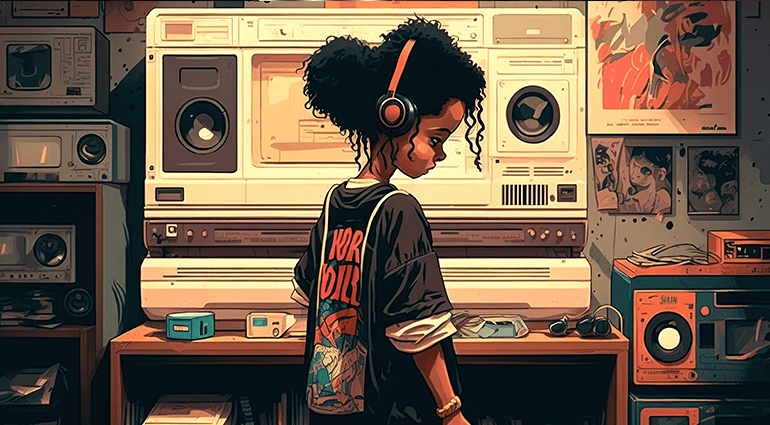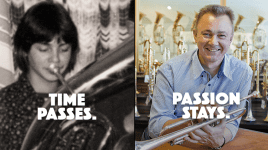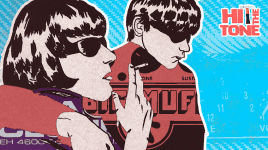
Like all styles of music, hip hop has diverse roots and was shaped by countless artists over the course of many decades. In fact, it has come a long way: From urban turntablism to rap battling, B-boying to street fashion, it has become a billion-dollar business. Having been created in 1973, this year marks the 50th anniversary of hip hop! Join us as we celebrate!
DJ Kool Herc and the birth of hip hop
On August 11, 1973, Cindy Campbell threw a back-to-school party in the community area of the apartment building located at 1520 Sedgwick Avenue in the Bronx. She had asked her brother Clive Campbell, who became known as DJ Kool Herc, to spin records at the event. As an aspiring DJ, Herc knew that the dancefloor is the heart of a good party. And he discovered how to keep the groove going: By using two turntables in parallel, he unknowingly started a new era of music and laid the foundation for what we now call hip hop.
The Merry-Go-Round and back-cueing
Herc pioneered a technique he called “Merry-Go-Round”, which he used to isolate the percussive elements of the “breakbeat”. Using two copies of the same record, Herc created continuous grooves by launching the second record the moment the first one reached its end. Herc transformed short breaks into long-lasting dancefloor action and inspired the break boys to hit the dancefloor and use their bodies to battle each other in the rhythm. His turntabling style and the technique he invented on this evening in August became one of the cornerstones of hip hop and led to Herc being recognized as the creator of hip hop. So, it’s no surprise that DJ Kool Herc was induced into the Rock ‘n’ Roll Hall of Fame this year, on May 3rd…
You are currently viewing a placeholder content from YouTube. To access the actual content, click the button below. Please note that doing so will share data with third-party providers.
Hip hop caught on quickly
The new style quickly conquered the neighborhood and the block parties of the ’70s in the Bronx and New York City became the historic cradle of hip hop. By manipulating records by hand, mixing various sounds using multiple turntables, and even recording everything on tape, DJs rose above their traditional role of spinning records. Soon after, the first MCs began to rap to these new beats. However, it seemed inconceivable at that point that hip hop would ever be played on the radio. This changed in 1979 with “King Tim III” by the Fatback Band and even more so when Sugarhill Gang released their first rap song “Rapper’s Delight”. For the first time, hip hop became noticed across the globe, and the golden age of hip hop began.
You are currently viewing a placeholder content from YouTube. To access the actual content, click the button below. Please note that doing so will share data with third-party providers.
Polarizing, political, and romantic
Back then, they were non-conformist pioneers. Today, artists like Grandmaster Flash, Run DMC, The Beasty Boys, Public Enemy, LL Cool J, and many more can be seen as the grandfathers of hip hop. They pushed the limits of the style and hip hop took its first steps toward the mainstream in the 80s. Run DMC was aired on MTV, LL Cool J wrapped romantic stories in hip hop and was the first to deliver catchy hooks, and Public Enemy used hip hop to get a political message across. But what they all had in common was that their lyrics dealt with the reality of life of the lower class. The next transformation came in 1986, when the rapper and actor ICE-T released his first album and created Gangsta Rap. The lyrics, songs, and videos became trenchant and reproachful, like in the song “Cop Killer” by Body Count, which decried the treatment of black people by the police.
You are currently viewing a placeholder content from YouTube. To access the actual content, click the button below. Please note that doing so will share data with third-party providers.
When Pandora’s box could no longer be closed
The contradiction between denouncing grievances on one side and the media-savvy glorification of violence, drugs, and the – so-called – gangster life on the other became deeper and deeper. What had begun as uncut truths became orchestrated provocation and the well-staged breaking of taboos, sometimes to the threshold of pain. In 1987, the album “Straight Outta Compton” was the first to be referred to as Gangsta Rap by the media. Suddenly, it was fashionable to promote oneself as being a criminal. The press had discovered that this kind of headline sold really well and kept adding fuel to the fire. That’s when the East Coast vs. West Coast beef started, fueled by the non-fatal shooting of Tupac Shakur in 1994. Tupac Shakur, better known as 2Pac, who sold more than 75 million records and was inducted into the Rock and Roll Hall of Fame in 2016, accused the rappers The Notorious B.I.G. and Puff Daddy of a set-up. The artists used their rivalry as a multiplier – and it worked. But the beef didn’t just boost record sales, it also had a dramatic dark side. Ultimately, it ended deadly for both Tupac Shakur, who was shot in September 1996, and The Notorious B.I.G., who suffered the same fate only half a year later. Both cases were never resolved.
You are currently viewing a placeholder content from YouTube. To access the actual content, click the button below. Please note that doing so will share data with third-party providers.
You are currently viewing a placeholder content from YouTube. To access the actual content, click the button below. Please note that doing so will share data with third-party providers.
Ruthless promotion through negative headlines
Around the year 2000, the statements became more and more extreme and irreverent. Artists like 50 Cent, Eminem, and Outkast came on the scene and obviously didn’t care about any consequences. Nothing was off-limits anymore and the rappers produced a string of negative headlines. One of them, let’s not mention his name here, even became famous because he had shot someone. Compared to this, the punks of the ’70s were well-behaved role models and a mother-in-law’s dream.
You are currently viewing a placeholder content from YouTube. To access the actual content, click the button below. Please note that doing so will share data with third-party providers.
Musical culture with lifestyle influence
By the 2000s, hip hop was everywhere and had long become recognized as a part of pop culture. Artists like Kanye West became global stars, whose sales figures easily eclipsed those of the Beatles. From around 2010, the various styles intermixed to an extent that made it impossible to put a label on the music. But this wasn’t an identity crisis – in fact, it was an advancement once again. Hip hop isn’t static and it continues to reinvent itself. And hip hop has always been much more than just a style of music – it’s a whole culture of which music is one element. The five pillars of hip hop: DJing, rapping (MCing), graffiti art, break dancing (B-Boying), and street fashion.
You are currently viewing a placeholder content from YouTube. To access the actual content, click the button below. Please note that doing so will share data with third-party providers.
Hip Hop: your feedback
Well then, to the next 50 years! We’re looking forward to your comments. Which hip hop artists and records are your favorites?
3 comments
Leave a Reply
You are currently viewing a placeholder content from Facebook. To access the actual content, click the button below. Please note that doing so will share data with third-party providers.
More InformationYou are currently viewing a placeholder content from Instagram. To access the actual content, click the button below. Please note that doing so will share data with third-party providers.
More InformationYou are currently viewing a placeholder content from X. To access the actual content, click the button below. Please note that doing so will share data with third-party providers.
More Information





Murray Calaway says:
I am a 54 year old who is still listening to 1980s & 1990s Hip-Hop. I am not as much into the newer stuff ( probably because of my age ). I will forever LOVE Hip-Hop.
Darryl Johnson (DJ) LOUISVILLE KENTUCKY says:
IM JUST HONORED AND PROUD HOLDING MY HEAD UP DAILY BEING A BLACK MAN LIVING HERE IN THE UNITED STATES ALL BECAUSE OF ( HIP-HOP) ITS NOT JUST A LIFE STYLE ITS MY CONFORMATION THAT AS A PEOPLE WE HAVE FINALLY ARRIVED SO AGAIN THANK YOU GOD BLESS ( HIP-HOP) FROM RAPPERS DELIGHT TO ANY AND ALL UP COMING ARTISTS WHOM HAVE A ( HIP-HOP) HEART & STATE OF MIND ITS A PRICELESS FEELING OF POSITIVITY AND A CULTURE GROWING DAILY. PEACE ✌️ LOVE AND HAPPINESS DAILY TO MY LOVE OF ( HIP-HOP) ONE LOVE 2 ALL😎😎😎😎😎😎😎😎😎😎😎
Miroslav says:
if